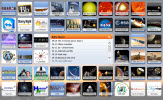August 2019
This month the only easily visible planets are Jupiter and Saturn, both of which are visible throughout the night hours. Mercury may be visible early in the month before the Sun rises, but it also will be low above the horizon.
The Perseids Meteor Shower peaks on the mornings of the 12
Click here for the month at a glance calendar.

The Southern sky from 45o south showing the Milky Way
and the area around Crux, the Southern Cross.
Mercury is visible in the morning skies befor sunrise for most of the month, and Mercury will reach its greatest western elongation on the 9th.
Venus is too close to the Sun and will reach superior conjunction, on the opposite side of the Sun, on the 14th
Mars is too close to the Sun to be seen this month.
Dwarf Planet Ceres is has an apparent magnitude of nearly 8.0 meaning it is not visible without optical assistance. It is located less than 10o from Jupiter and the reddish star Antares in Scorpius the Scorpion.
Jupiter rises around mid-day and is visible all night. Watch for a close conjunction with Moon on the 9th. Jupiter also ends its retrograde motion this month, on the 11th.
Saturn is visible all night and is located east from Jupiter. Watch for a close conjunction with the Moon on the 12th.












 Above the Solar System at 10 day Intervals
Above the Solar System at 10 day Intervals


 Lee's Summit, MO
Lee's Summit, MO 